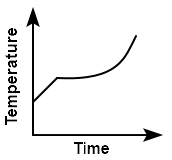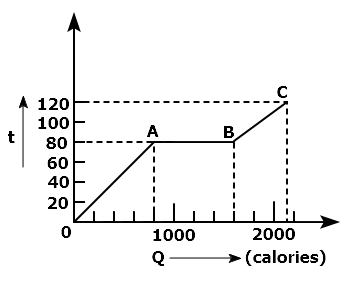Liquid oxygen at \(50\) K is heated up to \(300\) K at a constant pressure of \(1\) atm. The rate of heating is constant. Which one of the following graphs represents the variation of temperature with time?
| 1. |  |
2. |  |
| 3. |  |
4. |  |
Prefer Books for Question Practice? Get NEETprep's Unique MCQ Books with Online Audio/Video/Text Solutions via Telegram Bot
NEET MCQ Books for XIth & XIIth Physics, Chemistry & BiologyA piece of ice falls from a height \(h\) so that it melts completely. Only one-quarter of the heat produced is absorbed by the ice, and all energy of ice gets converted into heat during its fall. The value of \(h\) is: (Latent heat of ice is \(3.4\times10^5\) J/kg and \(g=10\) N/kg)
| 1. | \(544\) km | 2. | \(136\) km |
| 3. | \(68\) km | 4. | \(34\) km |
Prefer Books for Question Practice? Get NEETprep's Unique MCQ Books with Online Audio/Video/Text Solutions via Telegram Bot
NEET MCQ Books for XIth & XIIth Physics, Chemistry & BiologyOne kilogram of ice at \(0^\circ \mathrm{C}\) is mixed with one kilogram of water at \(80^\circ \mathrm{C}.\) The final temperature of the mixture will be: (Take: Specific heat of water = \(4200\) J kg-1 K-1, latent heat of ice\(=336\) kJ kg-1)
| 1. | \(0^\circ \mathrm{C}\) | 2. | \(50^\circ \mathrm{C}\) |
| 3. | \(40^\circ \mathrm{C}\) | 4. | \(60^\circ \mathrm{C}\) |
Prefer Books for Question Practice? Get NEETprep's Unique MCQ Books with Online Audio/Video/Text Solutions via Telegram Bot
NEET MCQ Books for XIth & XIIth Physics, Chemistry & Biology5 g of water at \(30^{\circ} \mathrm{C}\) and 5 g of ice at \(-20^{\circ} \mathrm{C}\) are mixed together in a calorimeter. The water equivalent of the calorimeter is negligible, and the specific heat and latent heat of ice are 0.5 \(\text{cal/g}^{\circ} \mathrm{C}\) and 80 \(\text{cal/g}\), respectively. The final temperature of the mixture is:
| 1. | \(0^{\circ} \mathrm{C}\) | 2. | \(-8^{\circ} \mathrm{C}\) |
| 3. | \(-4^{\circ} \mathrm{C}\) | 4. | \(2^{\circ} \mathrm{C}\) |
Prefer Books for Question Practice? Get NEETprep's Unique MCQ Books with Online Audio/Video/Text Solutions via Telegram Bot
NEET MCQ Books for XIth & XIIth Physics, Chemistry & BiologySteam at \(100^{\circ}\mathrm{C}\) is injected into 20 g of \(10^{\circ}\mathrm{C}\) water. When water acquires a temperature of \(80^{\circ}\mathrm{C}\), the mass of water present will be: (Take specific heat of water =1 cal g-1 \(^\circ\)C-1 and latent heat of steam = 540 cal g-1)
| 1. | 24 g | 2. | 31.5g |
| 3. | 42.5 g | 4. | 22.5 g |
Prefer Books for Question Practice? Get NEETprep's Unique MCQ Books with Online Audio/Video/Text Solutions via Telegram Bot
NEET MCQ Books for XIth & XIIth Physics, Chemistry & Biology\(150\) g of ice at \(0^\circ \mathrm{C}\) is mixed with \(100\) g of water at a temperature of \(80^\circ \mathrm{C}.\) The latent heat of ice is \(80\) cal/g and the specific heat of water is \(1\) cal/g°C. Assuming no heat loss to the environment, the amount of ice that does not melt is:
| 1. | \(100\) g | 2. | \(0\) |
| 3. | \(150\) g | 4. | \(50\) g |
Prefer Books for Question Practice? Get NEETprep's Unique MCQ Books with Online Audio/Video/Text Solutions via Telegram Bot
NEET MCQ Books for XIth & XIIth Physics, Chemistry & BiologyWhen the pressure on the surface of water is increased, its boiling point will:
| 1. | Decrease | 2. | Increase |
| 3. | Remain same | 4. | Increase or decrease |
Prefer Books for Question Practice? Get NEETprep's Unique MCQ Books with Online Audio/Video/Text Solutions via Telegram Bot
NEET MCQ Books for XIth & XIIth Physics, Chemistry & BiologyA substance is in solid form at \(0^{\circ}\mathrm{C}\). The amount of heat added to this substance and its temperature are plotted in the following graph. If the relative specific heat capacity of the solid substance is 0.5, from the graph, the specific latent heat of the melting process is: (Specific heat capacity of water = 1000 cal kg-1 K-1 )
| 1. | 60000 cal kg-1 | 2. | 40000 cal kg-1 |
| 3. | 10000 cal kg-1 | 4. | 20000 cal kg-1 |
Prefer Books for Question Practice? Get NEETprep's Unique MCQ Books with Online Audio/Video/Text Solutions via Telegram Bot
NEET MCQ Books for XIth & XIIth Physics, Chemistry & BiologyTwo identical bodies are made of a material whose heat capacity increases with temperature. One of these is at \(100^{\circ} \mathrm{C}\), while the other one is at \(0^{\circ} \mathrm{C}\). If the two bodies are brought into contact, then assuming no heat loss, the final common temperature will be:
| 1. | \(50^{\circ} \mathrm{C}\) |
| 2. | more than \(50^{\circ} \mathrm{C}\) |
| 3. | less than \(50^{\circ} \mathrm{C}\) but greater than \(0^{\circ} \mathrm{C}\) |
| 4. | \(0^{\circ} \mathrm{C}\) |
Prefer Books for Question Practice? Get NEETprep's Unique MCQ Books with Online Audio/Video/Text Solutions via Telegram Bot
NEET MCQ Books for XIth & XIIth Physics, Chemistry & BiologyIn an experiment on the specific heat of a metal, a \(0.20\) kg block of the metal at \(150^{\circ}\text{C}\) is dropped in a copper calorimeter (of water equivalent of \(0.025\) kg) containing \(150~\text{cm}^{3}\) of water at \(27^{\circ}\text{C}\). The final temperature is \(40^{\circ}\text{C}\). The specific heat of the metal will be:
(Heat losses to the surroundings are negligible)
1. \(0 . 40 ~ \text{Jg}^{- 1} \text{K}^{- 1}\)
2. \(0 . 43 ~ \text{Jg}^{- 1} \text{K}^{- 1}\)
3. \(0 . 54 ~ \text{Jg}^{- 1} \text{K}^{- 1}\)
4. \(0 . 61 ~ \text{Jg}^{- 1} \text{K}^{- 1}\)
Prefer Books for Question Practice? Get NEETprep's Unique MCQ Books with Online Audio/Video/Text Solutions via Telegram Bot
NEET MCQ Books for XIth & XIIth Physics, Chemistry & Biology
